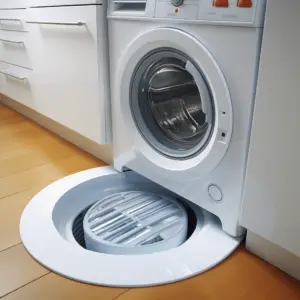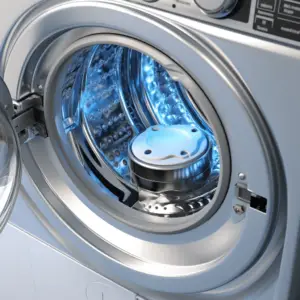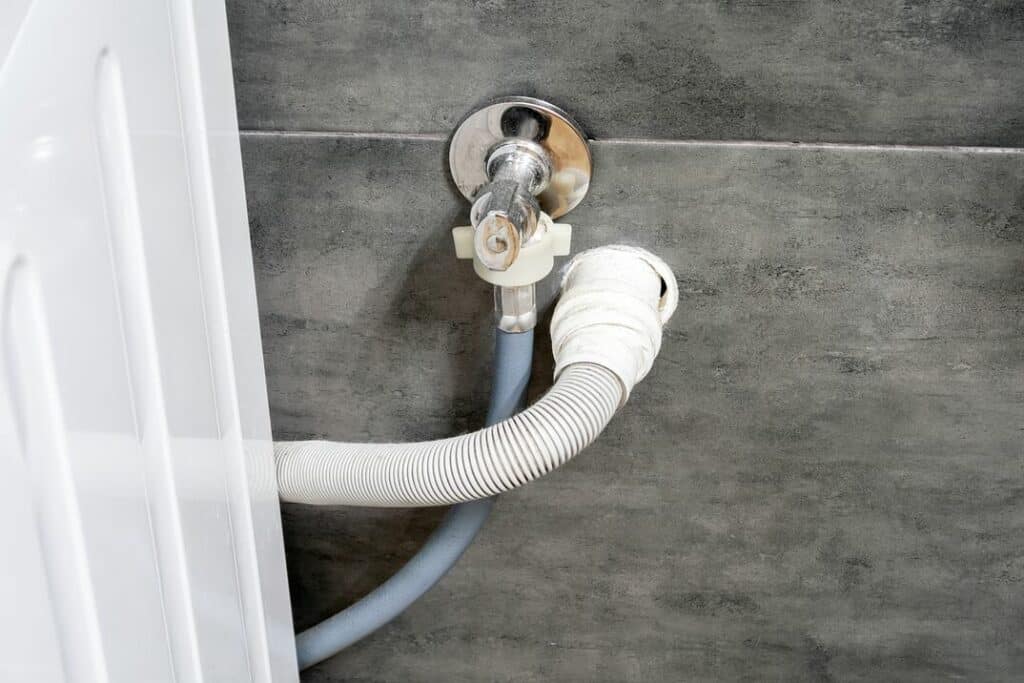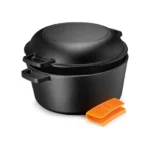If your laundry room floor is filled with water, your washing machine’s drain pipe is overflowing and causing the problem.
This is a typical issue, mainly if you live in a house built before 1970, because newer appliances have higher drainage flow rates that can overwhelm older plumbing systems. If this occurs, there is a solution to slow the leak down.
A quick but temporary fix to this issue is putting a restriction on your washing machine discharge hose. The water flow should be sufficiently reduced to stop the drain from overflowing.
Just be careful not to restrict the hose too much since this will result in a time-out and/or a premature move to the next cycle in your washing machine.
Table of Contents
How Can a Washing Machine Drain Overflow Be Fixed?

The best action is to change the drainage pipe if a washing machine drain is overflowing.
Older homes typically have pipes with a smaller diameter (about one and a half inches), which may work for high-efficiency models but are frequently insufficient for regular washing machines.
A two-inch drainage pipe installation should solve the issue.
Utilizing a wire lint catcher is another option. This tool prevents loose dirt, hair, and lint from clothes from entering the drain and blocking it by trapping them as they eventually escape the washer.
If you want the lint catcher to function correctly, you must be prepared to either clean or change it every month. However, it can survive up to twenty years if maintained properly.
How Can You Prevent Your Washing Machine Drainpipe from Overflowing?
The following are the best strategies to stop a washing machine drainpipe from overflowing:
Install a Laundry Sink
By installing a laundry sink, you can utilize a mesh lint catcher over the end of the drain pipe.
This will lessen the likelihood of debris like hair, lint, and dirt entering the drainpipe.
However, you must keep an eye on the lint collector and clean it periodically. Otherwise, it will clog and develop into a separate issue.
Buy a High-Efficiency Washing Machine
Less water is used by a high-efficiency washing machine than by a regular one, which reduces the amount of water that ends up in the drain.
Snake the Drain Regularly
Snaking the drain once every two to three months should help avoid an overflow issue, depending on how frequently you use your washing machine.
It’s usually time to clean the drainpipe when you notice the water is draining more slowly than usual.
Use Hot Water Mixed with Vinegar and Baking Soda
Running a whole kettle of hot water and a cup of baking soda down the drain every six months is advised.
After that, pour one cup of water and one cup of vinegar down the drain, then block it up.
Let the mixture sit in the hose for ten to fifteen minutes, and then pour another kettle of hot water down the drainpipe.
What Leads to an Overflowing Washing Machine Drain?
Your washing machine drain may be overflowing for several reasons. The drainpipe is the most likely offender.
Different substances, such as dirt, lint, and fabric hair, gradually accumulate inside the pipe over time, preventing the water from draining entirely.
Other factors include a twisted discharge hose, aging or failing pipes, pipes that are the wrong size, a missing p-trap, and/or a clog in the primary sewer system.
How Can a Clogged Washing Machine Drain Pipe Be Fixed?
Ensure your washing machine is off before you start to unclog a drain line and resolve your overflow issue.
Next, find the drainage hose at the appliance’s back. After that, cut the clip tying the drain hose to the washing machine using a pair of pliers to disconnect the hose.
Remove any obstruction inside the drainage hose using an auger or a long metal coat hanger. A bucket of water should then be used to flush the drainpipe.
After that, straighten the hose and check within it with a flashlight to ensure all the debris has been removed.
Reattach the hose to the back of the washing machine to complete the process. Give it a little tug to make sure it is securely fastened.
Your best option if you still have a leakage issue after that is to contact a licensed plumber.
If the leak persists, you run the risk of potentially compromising your home’s foundation or structural support.
Can a Washing Machine Drain Be Sealed?
The washer standpipe cannot be sealed when trying to slow down water from your washing machine drain.
However, a washer drain hose can be sealed. Follow the seven steps listed below to accomplish this.
- Unplug the power cord from the appliance.
- At one end of the hose pipe, slide an unfastened clamp an inch up the end of the hose.
- Put the hose end and the clamp on the outlet’s bottom on the washing machine’s back.
- Utilize a flat-head screwdriver to lock the hose clamp’s screw. This should tighten the band sealing the drain pipe securely around the outlet.
- Make sure the region where the drain hose meets the drain standpipe is at the same height as the tub’s maximum water level before inserting the opposite end of the hose into the standpipe.
- Use a nylon tie to secure the drain hose to the standpipe; take care not to over tighten the tie, as this will prevent water from draining from the machine effectively.
- Reconnect the power cord to the appliance.
How Can You Tell if the Drain on Your Washing Machine is Clogged?

An overflow of water is the telltale sign that your washing machine drain is clogged. Using a compressor to blast air through the drain, you may quickly determine whether or not it is clogged.
If the drain is clear, the appliance pump is probably the problem.
To increase the machine’s capacity to pump water efficiently, you should repair and/or reattach the hose if it is kinked, severely worn, damaged, or improperly attached.


